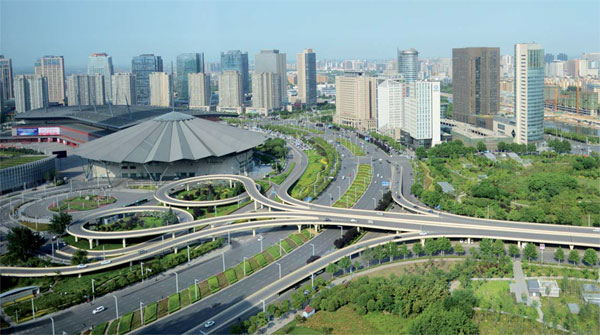Banishing ghosts
Updated: 2015-07-03 07:14
By Andrew Moody, Wang Chao and Qi Xin(China Daily Europe)
|
|||||||||||
Something strange is happening in China's so-called ghost cities: people keep coming
"I can't see any ghosts," exclaims Mel Lone, as he looks down out of his 29th-floor offices in Landmark Plaza over Zhengdong New District, the new part of Henan province's capital Zhengzhou.
Human activity can be seen everywhere, with the new highways streaming with vehicles and nearby offices and residential apartment blocks seemingly fully occupied.

|
Zhengzhou International Convention and Exhibition Center in Zhengdong New District. Xiang Mingchao / China Daily |
|
Rachel Murphy (left), a lecturer in the sociology of China at the University of Oxford; and Athar Hussain, director of the Asia Research Centre at the London School of Economics. Photos by Nick J.B. Moore / For China Daily |

|
Pupils play soccer at Juyuanlu Elementary School in Zhengdong New District. Photos by Xiang Mingchao / China Daily |
Yet just two years ago Zhengdong was dubbed one of China's so-called ghost towns by CBS' flagship current affairs program 60 Minutes, which pointed out empty office blocks and an absence of human existence.
"If someone looked at me and said there is a ghost, that would be a different story," laughs Lone, a 67-year-old, white-haired Pakistan-born businessman, who has lived in the new district since 2009.
His company, Greka, which extracts gas from coal using CBD (coal bed methane) technology of which he is chief operating officer, is one of a number of new businesses that have relocated to the city area in recent years.
According to a report by Standard Chartered, China Property - Mystery of Ghost Cities, published last year, the residential occupancy rate of Zhengdong was 30 percent in 2012. That had doubled to 60 percent by 2014 and now is almost certainly much higher.
Wade Shepard, author of Ghost Cities of China, says that by the time the CBS program aired in early 2013, the situation had changed dramatically from when it was filmed at the end of 2012.
"I was actually there in March 2013 and it looked a lot different from the program itself. There were a lot of Chinese banks with their regional headquarters located there when the filming was taking place," he recalls.
According to the same research by Standard Chartered, typical occupancy rates for a new district in China during the initial phase (first to fifth years of a development) are under 20 percent. They then increase to around 50 percent in the rapid growth phase (six to 10 years) and then to between 70 and 80 percent in the mature phase (11 to 15 years). Zhengdong, where construction started in 2003, is now in its mature phase.
"If you are urbanizing, it would take a genius to build a new city area at the same pace as demand," adds Shepard.
"There are inevitably going to be lags in some way, shape or form before you get the movement of people and businesses."
60 Minutes was not the first to suggest that China was creating ghost cities and that its urban development had somehow gotten out of control.
Ordos Kangbashi, built in the desert some 23 kiLoneters outside Ordos, the Inner Mongolia autonomous region, was itself the subject of media attention. One report by Al Jazeera in 2009 claimed that despite its giant skyscrapers and wide streets "nobody lived there".
Other areas that have attracted attention are Chenggong, a new district of Kunming in Yunnan; Dantu, part of Zhenjiang in Jiangsu; the new area of Linyi in Shandong; and the new urban area of Xinyang, which like Zhengdong, is in Henan.
Shepard believes even when occupancy rates in these areas were relatively low, they were rarely deserted as has been claimed.
"If you have a district of hundreds of 30-story apartment blocks and they are 50 percent empty, that is still a lot of people living in the area," he says.
Regardless of whether the scale and pace of China's urban development has been set at the right level, the world's second-largest economy has shown it has the ability to deliver such huge projects in a short space of time.
Much of the credit for that has to go to its planning system, which is renowned for being decisive and can anticipate needs many years ahead.
In many other countries, where there are often lengthy planning enquiries, urban development often lags well behind demand.
The UK, for example, has not built a new town or city since Milton Keynes in 1967 and is suffering a major housing shortage. Many other European countries have similar problems.
"No other country can just clear 65 square kiLoneters of land, move everybody out and build a new city," adds Shepard.
"The UK has an inadequate supply of affordable housing so it needs to change. That is not to say that China does not have issues. Through urbanization it has created this mass human migration, and to some extent it has to build these additional cities to cope with demand."
China's urban population exceeded its rural population for the first time in 2011 and at the end of last year stood at 54.7 percent, according to China's National Bureau of Statistics.
It is expected to reach between 70 and 75 percent by 2030, according to a recent report by the Chinese Academy of Social Sciences.
This would put it on the current level of many European countries such as Germany (73.9 percent) and Switzerland (73.7 percent), but behind the United Kingdom (79.6 percent), France (85.8 percent) and the United States (82.4 percent).
There has been a recent debate, however, as to whether China is beginning to reach the so-called Lewis Turning Point, named after the Nobel Prize-winning economist Sir Arthur Lewis, when the supply of cheap rural labor available to move to cities dries up.
Athar Hussain, director of the Asia Research Centre at the London School of Economics, doubts whether this is a major issue in the China context.
"The theory is that sooner or later there comes a point where there is no more labor to be transferred from rural to urban areas, but I am not sure of that," he says.
"The agricultural sector in China employs about 35 percent of the labor force but accounts for less than 10 percent of GDP. The whole point of Lewis is that development is driven by the difference in productivity between the modern and traditional sectors of the economy. In China, there is still a huge difference so there is still huge potential for the transfer of people to the cities."
Rachel Murphy, a lecturer in the sociology of China at the University of Oxford, says migration is an increasingly complex process in China, and it is difficult to reduce it just to something that occurs between rural and urban areas.
"So much of migration in China now is between cities. I have done a lot of research on return migration.Migrants who have gone to the big cities don't generally return to their villages but to small cities or towns, particularly if they want to create some form of business," she says.
Although it might have been described as a ghost city, Zhengdong New District, the central business district of which was one of the last great projects of the late Japanese architect Kisho Kurokawa, is actually now of strategic importance to China as the financial services hub of Central China.
It facilitates Zhengzhou's position as a vital logistics center for the government's Belt and Road Initiative.
It is home to HSBC, Bank of East Asia and Standard Chartered as well as insurance, leasing and futures trading companies - the last building on Zhengzhou's reputation as an agricultural futures trading center in commodities such as wheat, which dates back to the 1990s.
Wei Zhigang, chief of the financial services bureau of the Zhengdong New District Administrative Committee, says the plan is for Zhengdong not to be a regional financial services hub but an international one.
"Henan is already on the map because of the Belt and Road Initiative, but we are going to be increasingly a center for international trade with international cargo flights and also because it is possible to transport goods by rail to Hamburg in 15 days," he says.
One domestic bank that has its regional headquarters in Zhengdong is Zhongyuan Bank, the largest provincial-level commercial bank in China.
Hao Jingtao, the bank's regional executive vice-president, believes creating a new district with a financial center was exactly what the region needed.
He points out the district's financial institutions have already pledged 300 billion yuan ($48.9 billion; 44 billion euros) to companies across the province over the next five years.
|
 |
|
Hao Jingtao, Zhongyuan Bank's regional executive vice-president |
"It is developing to serve the needs of the whole region. With its green areas, its lakes, arts center, hospital and schools, it is a great place to work," he adds.
Juyuanlu Elementary School, whose pupils range in age from 6 to 14, might have looked like a ghost city school when it opened in 2006.
It then had just 56 pupils and had a fourth-grade class with just three. That was before the major migration to the district, and it now has some 2,400 students and about 175 teachers.
With modern facilities, including a huge artificial-surface sports field, the school would be the envy of many educational establishments in Europe.
Li Yongqiang, 43, who has been the principal from the beginning, says the school has its own energy.
"The difference with a school in an established area is that the pupils and the parents are from more diverse backgrounds. They have all come here for a better future," he says.
About one-third of the pupils' parents previously lived in Zhengzhou, and the rest mainly elsewhere in Henan province.
|
 |
| Mel Lone, COO of Greka |
Li says the school is increasingly becoming middle class because of the soaring price of property in the district.
"If you buy an apartment here now with many of them costing more than 14,000 yuan per square meter, you are almost beyond middle class."
New districts such as Zhengdong, far from being vanity projects, as some have suggested, are a continuation of an urban development model that began in the 1990s.
The most high-profile example is the development of Pudong on the west bank of the Huangpu River in Shanghai in 1993.
What was then farmland is now home to China's main financial center with iconic skyscrapers such as the Shanghai World Financial Center and the Oriental Pearl Tower.
"That was a ghost city for some time. It takes time for these areas to become population centers and become inhabited. You can't just flip a switch. In Shanghai, the government made all the banks move to Pudong," adds Shepard.
Comparisons have been made between China's urban development and that of Dubai, which suffered a property crash in 2009 from which it is still recovering.
Lone of the Greka energy company, who is a Canadian citizen and lives in a new residential development in Zhengdong, insists there is one big difference in that the United Arab Emirates city does not have a 1.3 billion population, but China does.
"They are all imported humans there like me," he laughs. "Here in China, they export them," he says.
He insists that Zhengdong, with its boulevards and amenities, has developed on a human scale.
"I grow my own fruits and vegetables in my back garden. The city is not congested, you feel you can breathe. All the major buildings have plenty of parking.
"It is not like Dubai in that you don't have to drive everywhere for basic needs. If my maid is cooking and she runs out of tomatoes, she only just has to go out of the door to buy some."
Contact the writers through andrewmoody@chinadaily.com.cn

(China Daily European Weekly 07/03/2015 page1)
Today's Top News
The future of China's 'ghost cities'
Power Link generates momentum with UK base
Russians will 'surprise' in victory parade: Ambassador
China-France partnership 'will benefit all'
Greece in billions of financing gap over next three years
Securities regulator fires up new policies to stem market plunge
Putin to meet Iran's President Rouhani at SCO summit next week
China stocks retreat in biggest three-week plunge since 1992
Hot Topics
Lunar probe , China growth forecasts, Emission rules get tougher, China seen through 'colored lens', International board,
Editor's Picks

|

|

|

|

|

|









